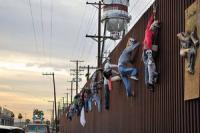-
2017 Critical Incident Exercise put first responder technologies to the test
In the wee hours of 29 October 2017, more than 200 people participated in a critical incident exercise and technology assessment, conducted by DHS S&T and partner organizations. The exercise took place at the Grand Central Terminal in New York City, with most of the action occurring on parked trains and on track platforms, and other indoor spaces within the Terminal. Emergency medical technicians were dispatched to quickly convert ramps in front of several track platforms into triage stations. Outside, first responders set up an incident command post and an operations center to coordinate the simulated response.
-
-
Prosecuting background check, straw purchase violations depends on state laws
A new study found that prosecutions in Pennsylvania for violating the state’s straw purchase law increased by nearly 16 times following the 2012 passage of a law requiring a mandatory minimum five-year sentence for individuals convicted of multiple straw purchase violations. So-called straw purchases involve a prohibited person, such as someone with a criminal record, enlisting the aid of another person to buy the firearm on their behalf.
-
-
Texas smugglers say Trump's border wall wouldn't stop immigrants, drugs from pouring across the border

If the Trump administration follows through on the president’s promises to build a border wall, would it actually stop undocumented immigrants and illegal drugs? Two former smugglers explain how they’d work around it.
-
-
Making production of high explosives cheaper, safer
Scientists from the U.S. Army Research Laboratory (ARL) and the Lawrence Livermore National Laboratory found a solution to a significant challenge in making high-energy explosives. They safely improved the overall chemical yield derived from diaminoglyoxime, known as DAG, and significantly increased the amount of material made per reaction.
-
-
Dog shoots man: Dog shoots his hunter-owner dead
A Russian hunter was fatally shot by his dog. Police investigators who examined the incident said that the man was shot when his dog stepped on the trigger of a loaded rifle. The man, on a hunting trip on Sunday, was letting his dogs out of the trunk of a car when one of the dogs stepped on the trigger of a loaded hunting rifle, killing the man.
-
-
Blast, impact simulations help researchers better understand injuries and body armor

Researchers at Sandia Lab have studied the mechanisms behind traumatic brain injury for about a decade. Their traumatic injury modeling and simulation project began with a head-and-neck representation, and now they’ve created a high-fidelity, digital model of a man from the waist up to study the minute mechanisms behind trauma. The specialized computer modeling and simulation methods help researchers better understand how blasts on a battlefield could lead to traumatic brain injury and injuries to vital organs, like the heart and lungs.
-
-
The man who knew too much

In November 2006, on orders of Vladimir Putin, Russian operatives used radioactive material to poison and kill Alexandr Litvinenko, a former KGB colleague who had turned a fierce critic of the Russian leader, and who was living with his family in London. Yesterday, the British government froze the assets of the two Russian agents – one of them has been awarded a medal by Putin, and is now a leading member of United Russia, Putin’s political party, in the Russian parliament. Ten years later, in November 2016, a leading British nuclear forensic scientist – who was part of the 2006 investigation and who was instrumental in tying the nuclear material used in the killing to the two Russian agents — was found dead in his home, after returning from an academic research trip to Russia. It was the 14th Russia-related killing on British soil since 2006. The number of individuals with inside knowledge of the Putin regime and its practices — and who have met an untimely end in mysterious circumstances — is growing, and British lawmakers urge the government to show more resolve in investigating this string of killings.
-
-
Draft U.S. document confirms Russian plans for “Doomsday” weapon
Some two years ago, Western intelligence and military experts scrambled to make sense of a strange new Russian weapon whose designs were glimpsed briefly in a mysterious report on Russian state TV. The weapon was a nuclear-capable underwater drone that would be launched from a submarine. The description accompanying a picture of the drone said such vehicles or weapons would be pilotless and capable of attacking enemies and creating “zones of extensive radioactive contamination unfit for military, economic or other activity for a long period of time.” Now, for the first time there are public indications that U.S. intelligence have not only confirmed Russian intentions for the weapon, but are also trying to figure out how to respond to it.
-
-
Predicting criminal risk: Court software may be no more accurate than web survey takers
A widely-used computer software tool may be no more accurate or fair at predicting repeat criminal behavior than people with no criminal justice experience, according to a new study. The analysis showed that non-experts who responded to an online survey performed equally as well as the Correctional Offender Management Profiling for Alternative Sanctions (COMPAS) software system used by courts to help determine the risk of recidivism.
-
-
U.S. gun deaths in 2017: 15,549 (excluding suicides) – 3 percent increase over 2016
At least 15,549 people were killed by guns in the United States in 2017, excluding most suicides, according to data collected by Gun Violence Archive (GVA), a nonprofit organization that tracks media and law enforcement reports of shootings. The number, which marks a 3 percent increase over the previous year. There were 31,157 firearm injuries in 2017, a rise of nearly 2 percent over the previous year. The number of people killed in mass shootings declined from 456 in 2016 to 433 in 2017.
-
-
Virgin Islands re-establishes disaster early warning system
The cabinet of the Virgin Islands has approved the expenditure of $442,000 to re-establish the National Early Warning System. Some of the networks were established as far back as 1979 and have been used to provide immediate warning and notification to persons throughout the territory. As a result of the National Early Warning Program, the Islands’ Department of Disaster Management (DDM) was able to apply for and receive Tsunami Ready Recognition in 2014 and this was renewed in June 2017.
-
-
Learning from Mexico's earthquake early warning system
In the company of only Japan and Taiwan, Mexico is one of few countries equipped with a seismic warning system that currently broadcasts publicly. Mexico has been broadcasting in a public regional capacity since 1993 via the Mexico Seismic Warning System, which currently has more than 90 sensors in central and southern Mexico. Although no one can reliably predict earthquakes, today’s technology is now advanced enough to rapidly detect seismic waves as an earthquake begins and send alerts to surrounding areas before damaging shaking arrives.
-
-
Thorium reactors could dispose of large amounts of weapons-grade plutonium
Scientists are developing a technology enabling the construction of high-temperature, gas-cool, low-power reactors with thorium fuel. The scientists propose to burn weapons-grade plutonium in these units, converting it into power and thermal energy. Thermal energy generated at thorium reactors may be used in hydrogen industrial production. The technology also makes it possible to desalinate water.
-
-
Hawaii’s missile alert gaffe: why good human-machine design is critical
It’s an unfortunate reality that we need to prepare for national emergencies due to war or natural disasters. Civil defense organizations, set up to coordinate and respond to such emergencies, are an important part of any modern state. Such entities play a critical role in terms of triggering alerts, coordinating response across law enforcement and emergency services, disseminating information and aiding response efforts to minimize impact and restore order. Clearly, they are important systems for alerting nations to risks when disaster strikes. But such systems can go wrong. Our interaction with technology is becoming more and more complex. Early warning systems are very welcome, but the Hawaii mishap serves as an opportunity for a radical redesign, with a better understanding of their impact on the population. At a time when the world is increasingly uncertain and our dependence on technology is so high, a redesign of poor warning systems is critical.
-
-
2018: Critical period of intensified risks
The Global Risks Report 2018, published this week by the World Economic Forum cautions that we are struggling to keep up with the accelerating pace of change. It highlights numerous areas in which we are pushing systems to the brink, from extinction-level rates of biodiversity loss to mounting concerns about the possibility of new wars. The reports says that the structural and interconnected nature of risks in 2018 threatens the very system on which societies, economies, and international relations are based – but that the positive economic outlook gives leaders the opportunity to tackle systemic fragility.
-
More headlines
The long view
Why Was Pacific Northwest Home to So Many Serial Killers?
Ted Bundy, Gary Ridgway, George Russell, Israel Keyes, and Robert Lee Yates were serial killers who grew up in the Pacific Northwest in the shadow of smelters which spewed plumes of lead, arsenic, and cadmium into the air. As a young man, Charles Manson spent ten years at a nearby prison, where lead has seeped into the soil. The idea of a correlation between early exposure to lead and higher crime rates is not new. Fraser doesn’t explicitly support the lead-crime hypothesis, but in a nimble, haunting narrative, she argues that the connections between an unfettered pollution and violent crime warrant scrutiny.
Bookshelf: Smartphones Shape War in Hyperconnected World
The smartphone is helping to shape the conduct and representation of contemporary war. A new book argues that as an operative device, the smartphone is now “being used as a central weapon of war.”
